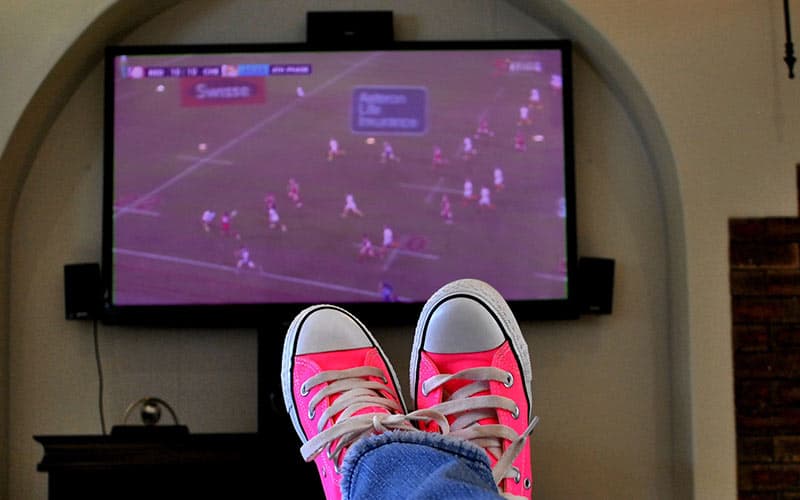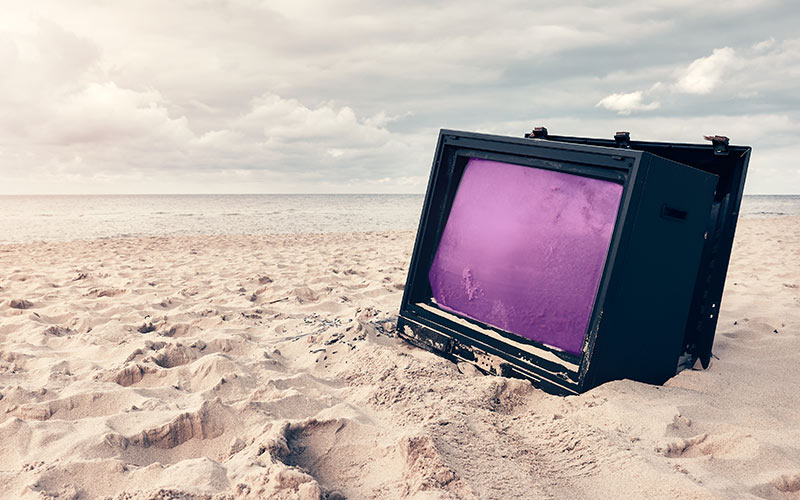Congratulations, you’ve about the millionth person who has been wondering “Why is my TV screen purple?” We’re saying congrats because you’ve landed in the right place to quickly and easily fix this problem, and because 99 out of 100 times, it’s a super quick and easy fix.
Common problems with easy solutions are our favorite kind!
Out of everything that could go wrong with a television, having a pink/purple tint to the screen is one of the easiest to diagnose and to fix. It’s easy to diagnose because you simple need to look at the screen, see that things are purple, and you can be almost positive of the cause.
So, without going into too much more preamble, we’re going to tell you what causes purple TV screen, how to fix it, and how to make sure it never happens again.
Let’s start with the most common and easiest to fix cause, since this is going to solve purple TV screen glitch for the vast majority of people. You can use the quick troubleshooting guide below to get right into it, or read the rest of the article for some additional insights and more in-depth instructions.
How to Fix Purple Tint on TV

Here are the most common fixes. A purple tint on a TV screen is usually an issue with HDMI, so here’s how to determine exactly which part of the chain is causing the problem. We’ll assume you have a device that connects via HDMI (such as a soundbar, speakers, a gaming console, a BluRay player, a TV box, a satellite receiver, an A/R receiver, etc…) and that said device is plugged into your TV via an HDMI cable. You’re getting a purple tint? Let’s fight out why…
- Try switching to a different HDMI cable.
- Try a different HDMI port on your TV.
- Try a different HDMI device to test the port on your TV.
- Try connecting your device without using HDMI, if it has other output options.
Based on what works and doesn’t work out of the above things, you can get a fairly reasonable idea what’s wrong.
For example…
If the device works, without a purple tint, when you plug it into a different HDMI port on your television, then we can safely assume there’s an issue with one of your TV’s HDMI ports.
If other HDMI devices work when plugged into the same port, we can assume there’s an issue with the initial device and nothing wrong with your TV.
If it works after switching to a different HDMI cable, we can assume the problem was with the initial cable and your TV and device are both fine (best case scenario).
No luck yet? No problem, keep reading…
Why Is My TV Screen Purple or Pink?
The most likely cause of a purple TV screen is a faulty HDMI connection.
A faulty HDMI connect can be caused by a cable that needs to be replaced, or a faulty HDMI port. We’re crossing our fingers that it’s the cable, since that’s the easiest and cheapest fix. If there’s an issue with the port, we’ll go over a few things you can do to workaround this without having to take your TV or your device to a repair shop, so stick around, even if it turns out your cable is just fine – we’ve still got some very useful information that will help you save a ton of time and money.
How To Fix a Purple TV Screen
The first thing to try is simple turning off your TV/connected devices, unplugging the HDMI cable, and then plugging it back in. Sometimes, that’s all it takes to fix a bad connection. So, start with that.
If that doesn’t work, you’ll want to try a new HDMI cable. You don’t need anything fancy, just make sure the type of HDMI cable you try meets the requirements of your devices. For example, there are regular old HDMI cables that are most commonly used, but there are also HDMI 2.0 or HDMI 2.1 cables that are meant for handling heavier bandwidth, like devices with higher refresh rates or higher resolutions such as 4K or 1440p.
An HDMI 2.1 cable is also backwards compatible with older devices, so if you aren’t sure which type of cable you need, it’s never a bad idea to over-buy and get the latest in HDMI tech, especially since HDMI cables are relatively affordable overall. If you know the old cable on your device is just HDMI 1.0, and it used to work fine, then you should be able to use any HDMI cable to troubleshoot. If the cable you’re using has never worked, it could be because you need a newer/higher spec cable, in which case get an HDMI 2.0 or 2.1 cable instead.
If you try a new cable and you’re still getting a purple tint on your screen, then the issue probably isn’t with the cable itself, but rather with the HDMI port that the cable plugs into.
If trying a different cable doesn’t work, then try using a different HDMI port on your TV, if you have more than one HDMI port. If this fixes the purple tint, but you need more HDMI ports since one is broken, you can get an HDMI splitter / HDMI hub for $20-$40.
Troubleshooting the HDMI ports can be tricky since there’s the port on your TV that the cable plugs into, and also the port on the device that connects to the cable, too. There are multiple areas here that can be causing the problem, and it really just takes trial and error. Here are some questions to answer that will help you troubleshoot…
Troubleshooting Purple Tint on TV
- Did it ever work in the past, or are you getting the purple tint right from the get-go, the first time you’ve plugged things in?
- Are you using the correct HDMI cable?
- Are there other HDMI ports you can test on your device, and/or on your television?
- Does this purple screen glitch happen all the time, or just occasionally?
- If you use a different device in the same HDMI port, is there still a purple tint?
Final Things To Consider…
It’s also possible that there’s nothing wrong with your TV nor the cable. It could be an issue with the HDMI port on the device itself (Whether that’s a BluRay player, a DVD player, a game console, or whatever else you’re connecting to the TV). In that case, those devices are usually less expensive than a TV, so it can be good news, in a way.
When it’s all said and done, sometimes you’ll have a faulty HDMI port and no other options but to get it fixed or get a new TV. The cost to repair an HDMI can vary, but you can expect to pay a couple hundred dollars. If your TV is older, and you only paid a bit more than the repair cost for it, unfortunately it’s usually just not economic to fix it. New TV’s are so affordable these days that you can sometimes get an even better TV for the same price as repairing an old one…
Still, it’s worth it to call a shop or two and see what they might charge for this, you could get lucky locally and find someone willing to repair a faulty HDMI port for $50 or $100, in which case it’s almost certainly worth doing the repair instead of getting a new TV and sending your old one to e-waste or a landfill.
